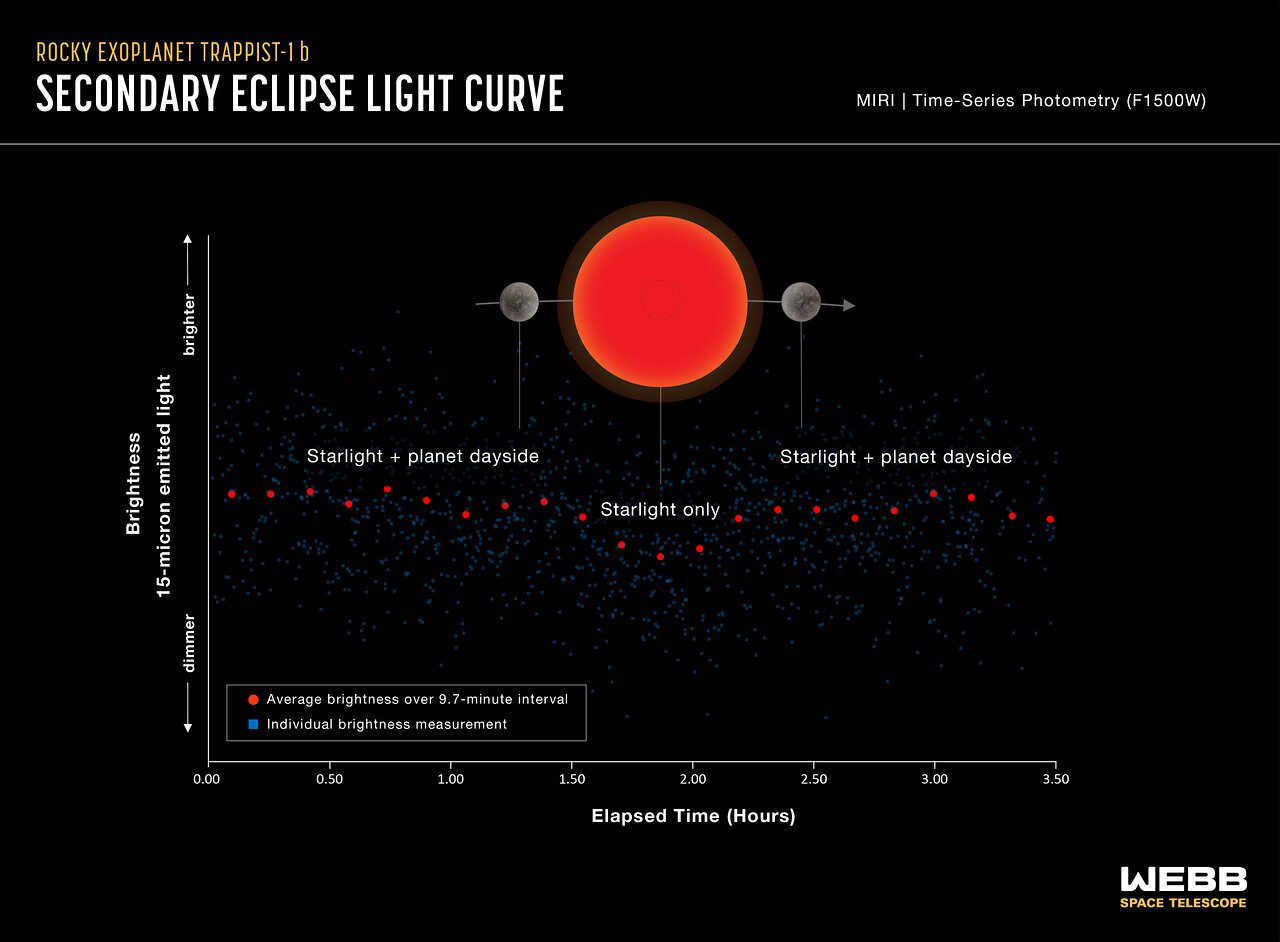JWST examined the nearby TRAPPIST-1 system in the hope of detecting atmospheres around its innermost planet, but alas, it seems it did not find one. Although TRAPPIST-1b was never considered a candidate for life, the absence of an atmosphere may be a bad sign for its more temperate neighbors, and for other planets orbiting close to cool, low-mass stars.
‘One-b or not one-b’, that is the question astronomers were asking as they turned the observing power of the JWST onto possibly the most interesting planetary system we have discovered, besides our own. TRAPPIST-1 not only consists of seven rocky planets with masses not dissimilar to Earth’s, but three or four (TRAPPIST-1e, f, and g) are arguably in the star’s habitable zone. At just 41 light-years from Earth, it’s close enough for easy study, and to top it off, the planets transit the star as seen from our location.
The transiting is the reason we found the planets. It also means that if any have atmospheres on them, we stand a chance of observing the effects when a planet passes in front or behind the star. Unfortunately, astronomers report that didn’t happen during a secondary eclipse of TRAPPIST-1b, making it likely the planet has little atmosphere to detect.
Previously, hopes were high for a thick TRAPPIST-1b atmosphere. Although the planet’s apparent radius is 20 percent larger than Earth’s, the mass is almost identical – a thick, Venus-like layer of cloud might explain this.
One way to detect atmospheres around distant planets is to look for changes in the starlight as they pass in front of their parental star. The light will get fainter because the planet itself blocks some of it, but some of what we do see could interact with gasses in the atmosphere, creating temporary dips in the spectra matching gasses present there.
That, however, is not what NASA’s Dr Thomas Greene and co-authors sought to do with TRAPPIST-1b, since it will take an enormous amount of observing time to collect enough light for this process. Instead, the authors noted the system’s innermost planet should be so hot the JWST should collect a substantial amount of infrared radiation from it. Anything we might detect, however, would be swamped radiation emitted directly by TRAPPIST-1 itself.

Light curve showing the change in brightness of the TRAPPIST-1 system as the innermost planet, TRAPPIST-1 b, moves behind the star. This is known as a secondary eclipse. Image credit: NASA, ESA, CSA, J. Olmsted (STScI), T. P. Greene (NASA Ames), T. Bell (BAERI), E. Ducrot (CEA), P. Lagage (CEA)
When the planet passes behind the star, known as a secondary eclipse, the radiation it reflects is hidden. Observing the drop in total emissions allowed Greene and colleagues to calculate the planet’s contribution. They conclude there is little sign of heat being redistributed from the planet’s permanent dayside to its night hemisphere.
“The most straightforward interpretation is that there is little or no planetary atmosphere redistributing radiation from the host star and also no detectable atmospheric absorption from carbon dioxide (CO2) or other species,” the authors write.
TRAPPIST-1 is a very faint star, putting out only about one two-thousandth as much light as the Sun. However, 1b is so close – taking just 1.5 days to orbit – it gets four times as much radiation as Earth does. Although that is less than Mercury experiences, it’s substantially more than Venus, so we can be quite sure its temperature is very high.
Why TRAPPIST-1b has no atmosphere is unknown. At 7.6 billion years old, it’s had plenty of time to lose one. Astrobiologists fear red dwarfs’ tendency to flare heavily may strip atmospheres from planets in their habitable zones, taking out most potential locations for life in the galaxy, and almost all of those within 10 light-years of Earth. Some researchers, however, argue the opposite.
Being even closer than the habitable zone, TRAPPIST-1b would be even more vulnerable to such atmospheric loss, so the absence of an atmosphere doesn’t rule out prospects for its siblings, but it’s not a good sign.
The study is published in Nature.
Source Link: JWST Dashes Any Hopes Of TRAPPIST-1b Being Potentially Habitable